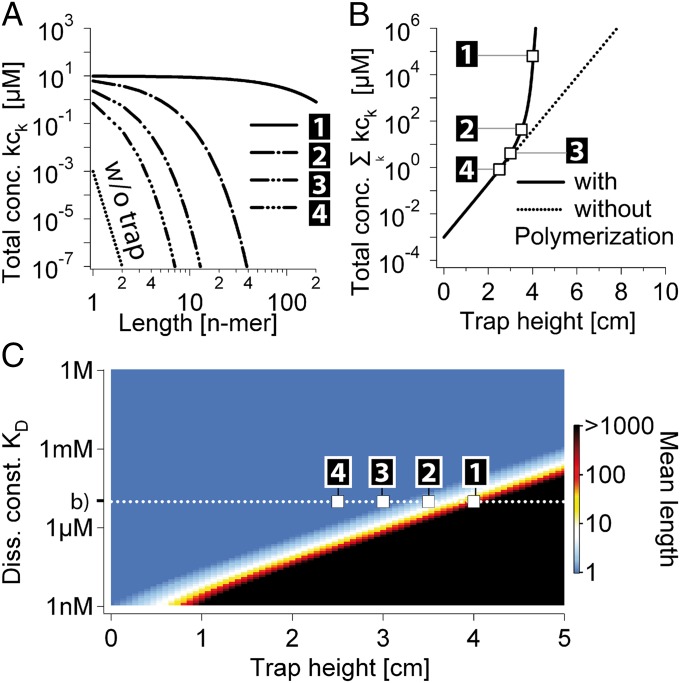Fig. 2.
RNA polymerization: accumulation and polymerization of RNA at the bottom of a primordial geothermal fissure. (A) Length distribution of a fast-reacting polymer ( ) inside a 2.5- to 4-cm (black boxes 1–4)-long trap at 100 µm width with a temperature difference of 10 K, an average trap temperature of 55 °C, a dissociation constant of
) inside a 2.5- to 4-cm (black boxes 1–4)-long trap at 100 µm width with a temperature difference of 10 K, an average trap temperature of 55 °C, a dissociation constant of  for polymerization, and an outside monomer concentration of 1 nM at physiological salt concentration (150 mM NaCl,
for polymerization, and an outside monomer concentration of 1 nM at physiological salt concentration (150 mM NaCl,  ). Oligomers with the size of active ribozymes are predicted to exist in the trap. (B) Escalation of polymerization. As soon as the total concentration of RNA monomers reaches the KD of polymerization, the polymer length and therefore the effective Soret coefficient of the polymers increase with the trap height
). Oligomers with the size of active ribozymes are predicted to exist in the trap. (B) Escalation of polymerization. As soon as the total concentration of RNA monomers reaches the KD of polymerization, the polymer length and therefore the effective Soret coefficient of the polymers increase with the trap height  . Therefore,
. Therefore,  grows hyperexponentially with
grows hyperexponentially with  . (C) Mean polymer length vs. pore heights and a broad range of dissociation constants KD. Even for low affinities, a plausible trap height is found at which polymerization escalates and the polymer length diverges. For polymerization slower than the accumulation, a similar behavior is found (Fig. S4, III). We conclude that the escalating growth of RNA length by a thermal trap is a robust phenomenon irrespective of the speed of polymerization.
. (C) Mean polymer length vs. pore heights and a broad range of dissociation constants KD. Even for low affinities, a plausible trap height is found at which polymerization escalates and the polymer length diverges. For polymerization slower than the accumulation, a similar behavior is found (Fig. S4, III). We conclude that the escalating growth of RNA length by a thermal trap is a robust phenomenon irrespective of the speed of polymerization.

